This Martin guitar took a serious fall, snapping the headstock off completely. See how we made it look like it never happened while keeping every bit of strength it had before.
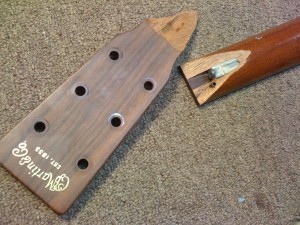
This is never how you want your Martin to look. But if your headstock does break off, you’d like to at least see a long break like this one with plenty of lateral gluing surface. Modern wood glues work their way into the pores of the wood, fusing them together again with incredible strength. Some repair shops take the approach of cutting away some of the wood and inlaying a dowel or a new piece to splice the two sides together. There are times when this is called for, but we try to avoid such measures whenever possible because it breaks and cuts even more of the wood fibers. If it ain’t broke don’t break it!
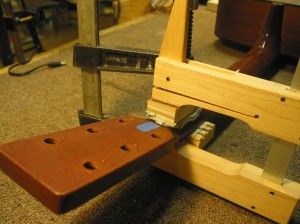
Before applying any glue, we used molding plastic to create a protective caul that fit the exact shape of the headstock. This will keep the clamps from crushing the neck while still applying enough pressure to actually heal the break. Once we have a perfect fit, we apply the glue and clamp it back up.
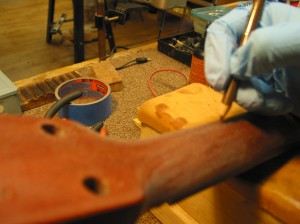
After the glue is dry and the clamps are off, we apply a small amount of colored finish over the break line. Then we carefully draw in dark grain lines to blend in with the rest of the neck.
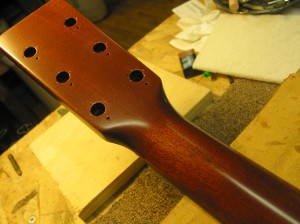
The break is now completely invisible…
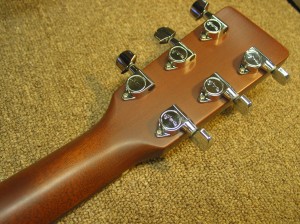
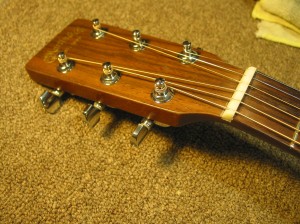
…and strong as nails. We guarantee this repair will hold until the next time it gets dropped and hits the ground (hopefully never again!)

absolutely gorgeous touch-up work on that. i have a lot to learn.
I am going to attempt to repair a Guild acoustic that has a cracked headstock with plenty of lateral surface. Do I just use plain old white wood glue for the repair?
We’d recommend Titebond or another carpenter/wood glue (or hide glue) instead of white glue. Good luck and remember to ‘measure twice and glue once.’ You don’t really get a second chance with that repair. If you’re not completely comfortable, I’d suggest taking it to a professional. There’s a reason why we charge for that repair – it’s not always as easy as it seems.
I was looking at a used D35 today where the back of the headstock was not as smooth and shiny as the back of the neck and was wondering if this was a sign of a neck repair. I couldn’t see any signs of repair but from your work you’ve proved that there may not be. The guitar is a 2003 model and the guy told me the neck was shinier due to oil from the hands. Is this true or is there another explanation for the difference in smoothness? Your
Jay,
Sorry it’s taken forever to respond to your question.
It’s impossible to say without seeing that guitar whether the neck was ever broken. The other fellow may be correct; skin oils and the constant rubbing on the back of a neck can definitely act like a buffing machine and shine the finish. A break in a clear-finished neck is usually visible to one extent or another. You just have to look very closely sometimes. The good news is that a well-done headstock repair should have no impact at all on a guitar’s sound or structural integrity. Remember, guitars are already held together by glue! If it’s done correctly (and we’re not talking about a collectible vintage instrument,) a repaired break shouldn’t really make a difference.